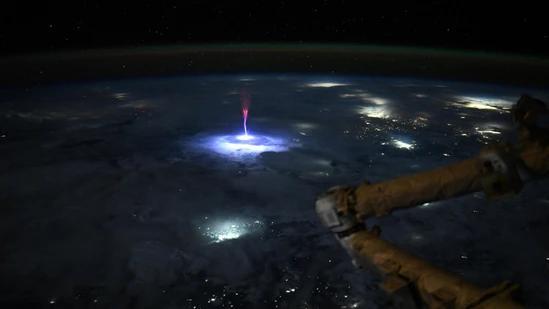
NASA Astronaut Captures Rare ‘Sprite’ Lightning Over US & Mexico
In a rare and breathtaking capture, NASA astronaut Nichole Ayers has shared a stunning photo of a ‘sprite’ lightning phenomenon from the International Space Station. The image showcases a brief burst of light above a thunderstorm, a type of Transient Luminous Event (TLE) known as a ‘sprite’. This extraordinary moment was captured while Ayers was orbiting above the United States and Mexico.
A ‘sprite’ is a type of rare and elusive atmospheric phenomenon that occurs when a massive electrical discharge from a thunderstorm interacts with the upper atmosphere. These brief, fleeting events are characterized by a sudden burst of light, often appearing as a bright, glowing arc above the clouds. In this particular instance, Ayers captured a ‘sprite’ in all its glory, offering scientists a unique opportunity to study this phenomenon and better understand its relationship to thunderstorms.
Ayers, a seasoned astronaut with multiple space missions under her belt, was thrilled to share her incredible capture with the world. “Scientists can use these types of photos to better understand the relationship of TLE to thunderstorms,” she said in an interview. “It’s an incredible opportunity to learn more about the Earth’s atmosphere and the complex interactions that occur within it.”
The ‘sprite’ captured by Ayers is just one of many TLEs that occur above thunderstorms, but it’s a particularly rare and extraordinary example of this phenomenon. These brief events are often difficult to capture due to their fleeting nature, requiring precise timing and location. In this instance, Ayers’ vantage point from the International Space Station allowed her to capture the ‘sprite’ in stunning detail, offering scientists a unique opportunity to study this phenomenon up close.
So, what exactly is a ‘sprite’? A ‘sprite’ is a type of TLE that occurs when a massive electrical discharge from a thunderstorm interacts with the upper atmosphere. This discharge creates a channel of ionized air, which glows brightly when it’s excited by the electrical energy. In the case of a ‘sprite’, this channel of ionized air can stretch for thousands of kilometers, creating a brief but intense burst of light above the clouds.
A ‘sprite’ is different from more common types of lightning, such as cloud-to-ground lightning or intracloud lightning. These types of lightning occur when a discharge of electrical energy occurs within or between clouds, creating a bright flash of light. ‘Sprites’, on the other hand, occur when a discharge of electrical energy interacts with the upper atmosphere, creating a brief but intense burst of light.
The study of TLEs, including ‘sprites’, has significant implications for our understanding of the Earth’s atmosphere and the complex interactions that occur within it. By studying these rare and fleeting events, scientists can gain insights into the behavior of thunderstorms, the movement of electrical energy through the atmosphere, and the role of the upper atmosphere in shaping our planet’s weather and climate.
In conclusion, NASA astronaut Nichole Ayers’ stunning capture of a ‘sprite’ lightning phenomenon over the United States and Mexico offers a rare and extraordinary glimpse into the complex and dynamic world of TLEs. This incredible image not only showcases the breathtaking beauty of this phenomenon but also highlights the importance of continued scientific study and exploration of the Earth’s atmosphere.






